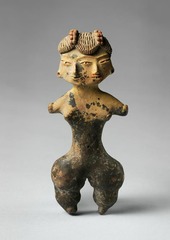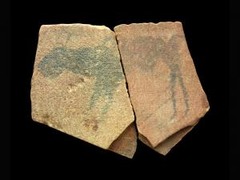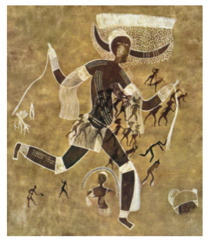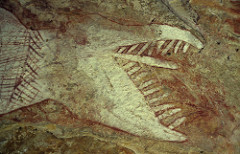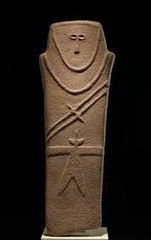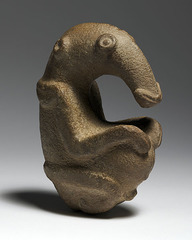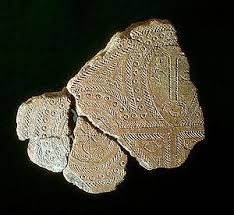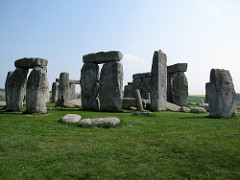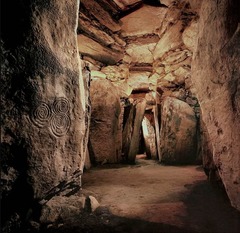Title: Tlatilco Female Figurine
Period/ Style: Paleolithic Old Stone Age
Date: 12000-900 BCE
Original Location: Tlatilco, Central Mexico
Material: Ceramic and pigment
Technique/Style/Description:
Statuette of a woman with a narrow waste, wide hips in the round, 2 faces, 3 eyes, 2 noses, and 2 mouths
subtractive method: The mixing of a limited number of dyes to create colors.
incised: decorative cuts
symmetry: pleasing to the eye
Message/ Meaning:
conjoined twins: seen as holy or divine
many curves: good, fertility, fascination with physical deformities and exaggerations
more senses than usual with more features than usual
3 eyes= insight into the spiritual world
duality: having 2 faces in the ancient world is often a good thing b/c ancient people saw their world in terms of contrast (dark light, sun moon, good evil, man woman) → one should not eliminate the other they should just be in perfect balance
Title: Apollo 11 Stones
Period/ Style: Paleolithic Old Stone Age
Date: 25,000 BCE
Original Location: Namibia, Africa
Material: Charcoal on stone
Subject: some kind of animal, not super detailed so hard to tell
Historical Context: one of the oldest pieces of art

Period/Style: Paleolithic Old Stone Age
Date: 15,000 BCE
Patron: Early humans in Lascaux, France
Original Location: France
Material: Paint on limestone and natural rock contours to show volume of animals
Subject: A man seems to be falling next to a powerful bison and rhino. The man seems to have a bird head. Possibly a scene from legends and animals could be Gods.
Technique/ Style/ Description:
composite view: Allows the head to face forward and the body to have a profile so as to depict as much of animals as possible.
Historical Context: Created in France and has to do with the hunter-gatherer society and concerns for food and survival.
Message/Meaning:
hybrid beast: Bird man is probably a priest, god, shaman, or magician trying to take on or channel the power of the bird.
bird: Can walk on the ground and fly in the heavens (equated with the heavens or the unknown.)
bird head: Could be turning into a bird or just wearing a mask. (ceremony and dance leads people to become animals spiritually)
man and bison: man is being killed (vulnerable), could be linked to mythological stories, maybe trying to control the bison, maybe instructions of what not to do
lack of human detail: animals were highly valued and it was believed that the more lifelike they were, the more power they had
Title: Camelid Sacrum (canine shaped)
Period/ Style: New Stone Neolithic Era
Date: 14,000-7000 BCE
Patron: Early humans in Mesoamerica
Original Location: Central Mexico
Material: animal pelvic bones
Subject: Bone appears to be carved in the shape of a canine head.
Historical Context: Used as a mask
Message/Meaning:
Sacrum: sacred, sometimes called the second or spiritual head
Sacrum (pelvis) significance: a lot of cultures from Mesoamerica to Europe believe that all knowledge travels down your spine and settles in the base of the sacrum (kind of like a third eye)
Title: Running horned woman
Period/ Style: Neolithic New Stone Age
Date: 6000-4000 BCE
Original Location: Algeria
Material: Pigment on rock
Subject: Woman running with a horn on her head.
Technique/ Style/ Description: Woman is very stylized and has a fancy headdress. Things are exaggerated but not focused on looking realistic.
Message/Meaning:
bull: A symbol of fertility and virility (masculinity). This woman has also taken on masculine symbols which is admirable.
possibly interpreted as a horned deity instead of a human.
Title: Lion-Human
Period/Style: Paleolithic Old Stone Age
Date: 30,000 BCE
Original Location: Germany
Material: Ivory carving
Technique/ Style/ Description:
statuette: mini statue (petite and portable)
sculpted in the round: All sides have been developed b/c meant to be seen from all sizes
subtractive method: carving or taking away (as opposed to additive, putting clay on something)
Message/ Meaning:
lion-man: humans try to connect themselves to the power of the lion because they want to be predators and to control nature
Title: Rainbow Serpent
Period/Style: Neolithic New Stone Age
Date: 6000 BCE
Original Location: Australia
Material: Pigment on rock
Subject: the serpent and its symbolism
Historical Context: right at the point of the writing of Genesis (book of Adam and Eve), before the writing the serpent had positive connotations in different cultures
Message/Meaning:
serpent: fertility, rebirth (before Genesis, women were powerful, positive symbols until the serpent approaches Eve/ shedding for new skin), resurrection (dies like a phoenix and rises from its own flesh when it sheds)
cyclical nature of life
coiled shape: circular, belief that everything worked in circles not linearly
ie- seasons
Title: Anthropomorphic Stele
Period/ Style: Neolithic New Stone Age
Date: 4000 BCE
Original Location: Arabian Peninsula
Material: Sandstone
Technique/Style/Description: carved sandstone in the shape of a human with a sword
Historical Context: Probably a grave marker for protection.
Message/Meaning:
anthropomorphic: human shape, human like characteristics, appears to be wearing human clothes
stele: vertical slab usually of stone used to mark or proclaim something
Title: The Ambum Stone
Period/ Style: Neolithic New Stone Age
Date: 1500 BCE
Original Location: Papua New Guinea
Material: Greywacke (type of sandstone)
Subject: anteater in embryonic form
Historical Context:
one of the earliest known Pacific works of art
Message/ Meaning:
zoomorphic: animal form or gods of animals
Title: Woman (Venus) of Willendorf (and other "Venus" statuettes)
Period/Style: Paleolithic Old Stone Age
Date: 24,000 BCE
Original Location: Eurasian Continent
Material: stone, paint pigments from the earth
Technique/ Style/ Description:
incised (carved) on cave walls
stylized: not natural, exaggerated ways to represent something
Message/ Meaning:
fertility, procreation, women
hips/ fat/ voluptuous qualities are admirable
Title: Terra cotta fragment
Period/ Style: Neolithic New Stone Age
Date: 1000 BCE
Original Location: Reef Islands
Material: Terra cotta
Technique, Style, and Description:
incised terra cotta
repeating geometric patterns
Historical Context: Pottery used for cooking, serving, and storing things.
Title: Stonehenge
Period/Style: Neolithic New Stone Age
Date: 2500-1600 BCE
Original Location: United Kingdom
Material: Sandstone
Technique/ Style/ Description
henge: deliberate circling of stones
megalith-large stone: over 20 feet tall and 50 tons, make noise when they are hit
trilithon: structure consisting of 2 vertical and 1 horizontal post
post: vertical
lintel: horizontal
Historical Context:
built over centuries
longest standing man-made structure
stones brought from hundreds of miles away
possible animal/human sacrifice
space predictions: pilgrimage site, burial ground, astronomical observatory
Message/ Meaning:
function: marker of summer and winter solstice, most likely religious
circle: Cyclical nature of life, something magical happens when you enter the circle
inside: probably most sacred
Title: Tomb Interior with Corbelling and Engrave Stones
Period/Style: Neolithic New Stone Age
Date: 3000-2500 BCE
Original Location: Ireland
Material: Stone
Technique/Style/Description:
corbelling: to build an arch with rows or layers of stones
Message/Meaning: care and concern for people that have died, giving them the possibility of afterlife
